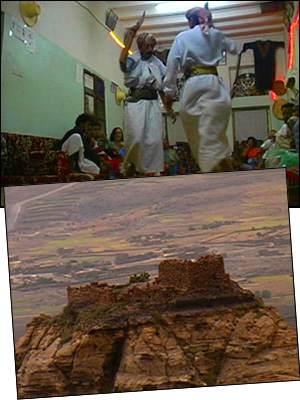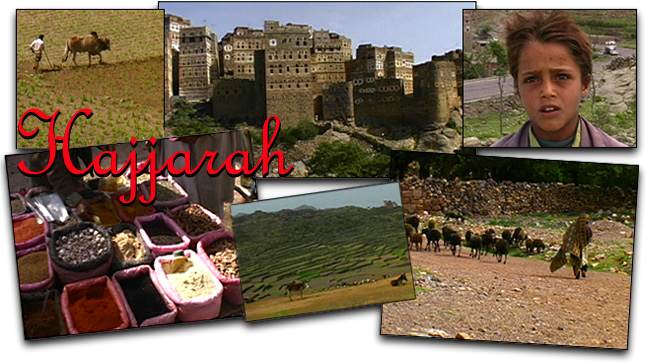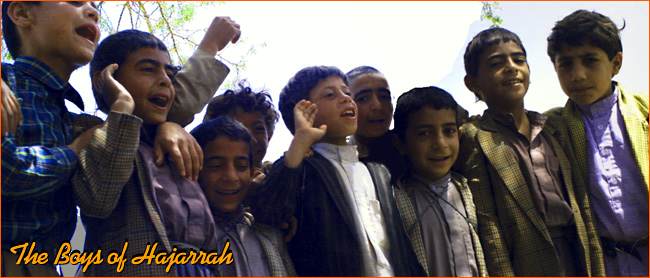|
Hajjarah is one of the most popular destination spots in the Harraz region of Yemen. The stepped mountains climb to the sky from the valleys below, covered with rows of terrace gardens. Located between Sana'a, the capital of Yemen, and the Red sea, Harraz has traditionally been a region of strategic importance. The region also provides much of Yemen's fresh produce.
The changing altitude of these amazing gardens allows for virtually any plant, from any climate, to be successfully grown in this region. From sweet berries to coffee, it's all in Harraz.
We trekked along one of the only roads in the region which followed a stream along the valley floor. The road began to climb and it kept climbing. We eventually reached an altitude of 7,546 feet. A view of the horizon revealed rows and rows of distant mountains, each decorated with small stone villages clinging to their sides and perched on their plateaus. The climb was envigorating and we were careful to drink plenty of water at regular intervals. Despite the altitude, breathing was no problem and the view was more than worth the effort.
|
 One of the most desirable destinations in this mountain region is the elevated town of Hajjarah. There is only one funduq in Hajjarah, The Hajjara Tourist Hotel, and this beautiful respite is located atop a high summit. The hotel has wonderful faire, about a dozen spacious rooms with amazing views, and a couple of lounges where patrons can either chew qat or listen to live traditional music. Don't be surprised if the dancers call you to join them. Yemeni dancing has simple steps. The kind of thing it takes a minute to pick up and a life time to master.
One of the most desirable destinations in this mountain region is the elevated town of Hajjarah. There is only one funduq in Hajjarah, The Hajjara Tourist Hotel, and this beautiful respite is located atop a high summit. The hotel has wonderful faire, about a dozen spacious rooms with amazing views, and a couple of lounges where patrons can either chew qat or listen to live traditional music. Don't be surprised if the dancers call you to join them. Yemeni dancing has simple steps. The kind of thing it takes a minute to pick up and a life time to master. In the lounge we met trekkers from Japan, Germany and Italy. We shared stories and learned of new paths to explore the following day. After a refreshing cup of shai, we relaxed and watched the talented musicians and graceful dancers celebrate the start of the Yemeni weekend, which begins on Thursday night. One of the most well known of the Aden region's dancers [left] was performing during our stay. He had grace and stamina. The younger dancers watched his technique from the soft cushions lining the walls. Tradition is strong in Yemen, and the dancing is no exception. The region was extremely fertile. Sheep and goats grazed down in the valley. Farmers [top] plowed their terraces behind oxen and children played in and around the irrigation pools. Hajjarah was a farm community full of friendly people. The many mountain ranges begged to be trekked and the variety of local suqs beckoned to be explored. It was one of the few places in Yemen where we could have stayed put for a week.
|
|
Mountain living
Even in the mountains, Islamic tradition segregated the sexes at an early age. In Yemen we saw mostly men. The women were working on the farm or in the home. But the children of both sexes played outside in groups and were quick to notice our crew. "Where are you from?" was the first question the children asked. Their English was much better at 9 or 10 years old than one might expect. The children freely interact with visitors. Gary mesmerized a group of boys with the digital camera, showing them their own images on the small screen. A group of school children assembled and giggled before one of the boys suggested that they sing a song for us. They all agreed and, after a few false starts, they sang us a charming round. The boys exploded in peals of laughter when Gary played back the impromptu concert for the plucky performers. These boys were at the age where boys receive their jambia, or curved knife. A scaled down version of the adult jambia usually has a nail inserted to prevent the blade from being drawn from the decorative case. Most boys find ways of removing the pin and quickly learn how to hold the jambia while performing steps to the traditional jambia dances. Most all of the boys and men wear sports jackets and colorful dress shirts as well as their personal jambia. The women often wear veils and only show their eyes in public.
Marriages
Marriages are usually arranged by the boy's older sister in cooperation with the parents of the prospective wife. The bride lives with her husband and his family but remains connected to her family. Her brothers and father ensure that she is treated with respect and avenge any misconduct towards her. Marriages are usually consentual and family life appears calm as there is little room for infidelity or flirtation under Islamic law. We spoke frankly with many women and they all seemed quite contented with their lives. They were treated very well and they were loved by their families. Perhaps this is a recipe for happiness.
The Ladies
Fatima and Sky used an English/ Arabic dictionary to chat about their lives. Later, they were able to look at pictures on the laptop computer of her hometown of Taiz.
"Mamma, Poppa, henna!" she pointed to the screen, to a neighborhood close to the base of Jabal Sabre. Sky gave Fatima a bottle of burgundy colored nail polish as a token of their friendship. The next morning, just before we left, Fatima gave Sky a red washing-cloth she had crocheted especially for her. It was the perfect thing to get the grime of the road off at the end of the day. They exchanged addresses and hugged good-bye. Sky felt honored that she could interact with this lovely Yemeni woman. She had many moments like this in Yemen and made many women friends. It was fascinating to learn first hand about the lives of women in an Islamic world. These are just the types of cultural exchanges that are possible when you hike through the small villages of this mountain country.
|

The Fortress and Steppes of Hajjarah Hajjarah was originally constructed as a safe house for dignitaries. Constructed from local sandstone and basalt, later decorated with white gypsum paint, the homes of Hajjarah were windowless on the bottom floors. The solid walls served as a protection against invasion. These lower floors were used for protecting livestock and for grain storage. The upper floors were reserved for the family living quarters. The main living room was typically situated on the top floor. These living rooms usually had many airy windows and were furnished with pillows and low couches. Yemeni homes were designed for comfort and furnished to provide maximum hospitality to friends, family and visitors. Hajjarah is the landscape one might expect to find in a fairy tale. These remote areas are still unknown to the Western world, and especially to American tourists. They are an ideal classroom for architecture, history, culture and art. Our guide, Ahmed, had correctly described Hajjarah as "breathtaking." Hajjarah is easily one of the most amazing places I have ever seen.
|


 The women that Sky, our female trekker, met were as curious about her life as she was about theirs. On the shore at the Red sea, Sky met a young woman named Fatima. They greeted each other with a nod. There was no one on the beach. She lifted her veil and Sky lifted hers. They smiled at each other. Sky had a new friend.
The women that Sky, our female trekker, met were as curious about her life as she was about theirs. On the shore at the Red sea, Sky met a young woman named Fatima. They greeted each other with a nod. There was no one on the beach. She lifted her veil and Sky lifted hers. They smiled at each other. Sky had a new friend.